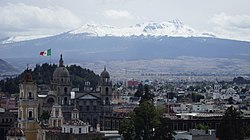
Back Toluca Afrikaans تولوكا Arabic تولوكا ARZ Toluca BAN Toluca de Lerdo BAR Талука-дэ-Лерда Byelorussian Толука Bulgarian Toluca Breton Toluca Catalan Toluca (kapital sa estado) CEB
Toluca, Mexico | |
|---|---|
State Capital | |
| Toluca de Lerdo | |
 | |
|
| |
 Location of Toluca in the State of Mexico | |
| Coordinates: 19°17′33″N 99°39′25″W / 19.29250°N 99.65694°W | |
| Country | |
| State | |
| Region | Toluca |
| Metro area | Greater Toluca |
| Municipality | Toluca |
| Municipal Status | December 13, 1812[1] |
| Municipal Seat | Toluca de Lerdo |
| Government | |
| • Type | Ayuntamiento |
| • Municipal President | |
| Area | |
• City | 452.37 km2 (174.66 sq mi) |
| • Water | 7.30 km2 (2.82 sq mi) |
| Elevation (of seat) | 2,660 m (8,730 ft) |
| Population (2020 Census) | |
• City | 223,876 |
| • Density | 490/km2 (1,300/sq mi) |
| • Urban | 2,476,689 |
| • Metro | 2,353,924 |
| GDP (PPP, constant 2015 values) | |
| • Year | 2023 |
| • Total (Metro area) | $35.6 billion[2] |
| • Per capita | $13,600 |
| Time zone | UTC-6 (Central) |
| Postal code (of seat) | 50000 |
| Area code | 722 / 729 |
| Demonym | Toluqueño (a) |
| Website | Official website (in Spanish) |
Toluca [toˈluka], officially Toluca de Lerdo [toˈluka ðe ˈleɾdo], is the state capital of the State of Mexico as well as the seat of the Municipality of Toluca. Toluca has a population of 910,608 as of the 2020 census. The city forms the core of the Greater Toluca metropolitan area, which with a combined population of 2,347,692 forms the fifth most populous metropolitan area in the country. Located 63 kilometres (39 mi) southwest of Mexico City, the city's rapid growth stems largely from its proximity to the capital.
It is mainly an industrial city that borders Metepec, one of the richest municipalities in the country. The Toluca Valley has a good level of infrastructure. Its airport is considered the first option to relieve Mexico City and the first stage of the "El Insurgente" interurban train will soon come into operation, later with a maximum speed of 160 kilometers per hour and a length of 58 km it will link Toluca with Mexico City. It is connected 66 kilometers to the east with the Valley of Mexico, made up of Mexico City and its metropolitan area.
Thanks to citizen pressure over the last decade, urban cycling is promoted and the agreement signed with the United Nations Organization for the use and respect of the bicycle as a sustainable means of mass transportation. Its tourist attractions are several due to the great cultural and artistic heritage that has managed to keep alive the union of Hispanic and indigenous culture. Its traditional portals, the Cosmovitral botanical garden and multiple parks, museums, centers and cultural events stand out, among which the Alfeñique Fair stands out, on the occasion of the annual Day of the Dead festival, and the Toluca International Film Festival.
Toluca is located at 2600 meters above sea level, being the highest capital city in Mexico and North America, which makes it temperate throughout the year with average temperatures ranging between 6 and 25 degrees Celsius during spring and summer, and from −5 to 20 degrees Celsius in winter. Its climate is temperate subhumid with rain in summer. Its altitude favors the practice of high-performance sports, but as it is one of the most polluted cities in the country due to the emissions of its industrial corridor and the poor motorized public transportation of the last 3 years, outdoor exercise carries some risks for health.
The Deportivo Toluca Fútbol Club is the largest sports institution in the city which was founded on February 12, 1917. The club's stadium Estadio Nemesio Diez. It was officially inaugurated on August 8, 1954, and has a capacity for 30,000 spectators. Currently, the men's club has been participating in the Liga MX since 1954. It also has a women's professional soccer club Deportivo Toluca Femenil that has participated in the Liga MX Femenil since in 2017, the women's club was founded in 2017. The club plays its home games at the Estadio Nemesio Diez.
- ^ "Enciclopedia de los Municipios y Delegaciones de México". Instituto Nacional para el Federalismo y el Desarrollo Municipal. Archived from the original on 24 September 2015. Retrieved 23 August 2015.
- ^ "TelluBase—Mexico Fact Sheet (Tellusant Public Service Series)" (PDF). Tellusant. Archived (PDF) from the original on 13 January 2024. Retrieved 11 January 2024.

